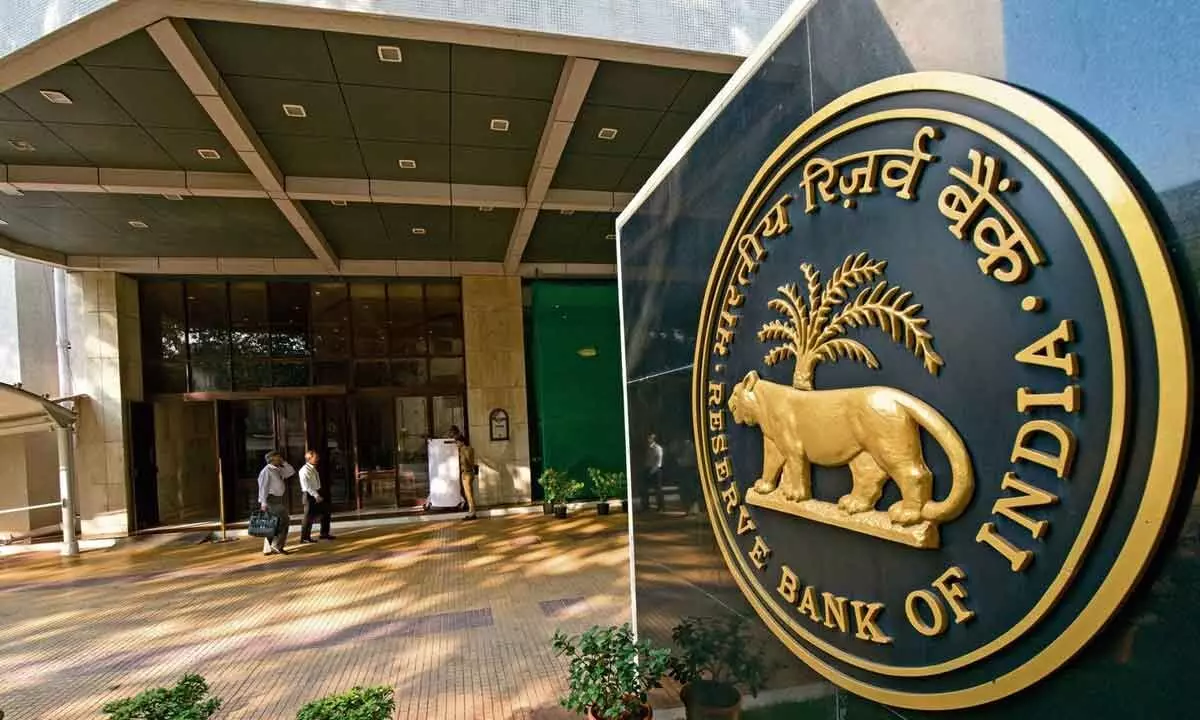War on inflation: RBI likely to hike rates again
Repo rate may go up by 40 & 35 bps and CRR by 100 bps in June & Aug
image for illustrative purpose

Mumbai: The Reserve Bank of India (RBI) may hike its repo rates by 40 basis points (bps) and 35 bps in June and August policy reviews, whereas CRR may be increased by 100 bps during the period, says an SBI study.
CPI inflation surged to 7.79 per cent on yearly basis in April as compared to 6.95 per cent in February mainly on account of food price inflation. Inflation prints are now likely to stay higher than 7 per cent till September. Beyond September, inflation prints could hover between 6.5 per cent-7 per cent. Our FY23 inflation forecast is at 6.5 per cent, taking into account the possibility of an extended food price shock.
The Russia-Ukraine conflict has significantly impacted the trajectory of inflation. The latest April inflation print shows wheat, protein items (chicken in particular), milk, lemon, cooked meal, chillies refined oil, potato, chillies, kerosene, firewood, gold and LPG are contributing to overall inflation in a substantive manner. Interestingly, inflation in protein items like chicken, mustard oil etc. softened in April. However this might be an aberration, given that April was the month of Navratri and other religious festivals. This is also reflected in increase in prices of milk and even fruits like mangoes.
Surprisingly, the contribution of petrol and diesel in overall inflation has been declining steadily since October while there is a steady increase in weighted contribution of kerosene and firewood in headline inflation. The significant increase in weighted contribution of kerosene perhaps reflects the impact of high fuel costs in rural areas. This does not augur well for rural demand. The weighted contribution of LPG has also increased reversing a downward trend. This however, may be attributed to commercial usage of LPG.
"We now expect RBI to raise rates both in June and August policy meeting by a cumulative 75 basis points. Beyond August, rate actions might be more balanced and judicious. We are expecting the terminal repo rate to be 5.15 per cent-5.25 per cent by FY23. The rupee has sharply depreciated against the dollar on account of galloping inflation both in the US and domestically. Aggressive rate hikes in the US have strengthened the dollar against the basket of currencies. The Dollar index gone beyond 104, its highest since December 2002," says SBI group's chief economic advisor, Soumya Kanti Ghosh.
Based on ASCB housing loan data from 2005, the SBI's internal economic research has estimated that 8.75 per cent is the threshold weighted average lending rate for housing loan beyond which housing loan disbursals might decline. This is tantamount to saying RBI should not increase the repo rate by more than 1.25 per cent for an incremental negative contribution to kick in. With 40bps hike already done in May, repo may not be increased more than 80 bps, i.e. upper limit should be 5.25 per cent (5.15 per cent Repo rate+10 bps CRR impact). This would imply a full transmission of 125 basis points over and able the current EBLR of Banks.
Meanwhile, system liquidity is still in surplus mode with net durable liquidity at Rs 6.8 lakh crore. RBI may increase the CRR rate by another 100 bps, after raising it by 50 bps in the last monetary policy. This would lead to absorption of Rs 1.74 lakh crore from the market on durable basis (Rs 87,000 crore absorbed earlier).
High Government borrowing has ruled out the possibility of OMO sale, thus CRR increase seems as the possible non-disruptive option of absorbing the durable liquidity. Furthermore, this opens up space for RBI to conduct liquidity management in future through OMO purchase. RBI can give back to the market at least 3/4th of the Rs 2.6 lakh crore absorbed through CRR hike or Rs 1.95 lakh crore in some form to address duration supply. This would lower the Market Borrowing to around Rs 12.36 lakh crore for FY23 compared to the BE of Rs 14.3 lakh crore.
Additionally, the rupee has accordingly moved northwards breaching the 77-mark. With normalization of LAF corridor, it was expected that rupee will witness some volatility. The FII outflows in the equity may persist as normalization of interest rates in advance economies will impact the growth outlook in emerging markets. Rupee is expected to move in range Rs 75-78 with swings on either side. The hardening of rate outlook in the US, leading to shunning of risks across asset classes has seen windfalls for the Dollar index whose marauding strength has taken it to 20 year highs, creating a free fall for many other currencies, the perplexing situation exacerbated by persistent FPI outflows in massive numbers.
The fall of the rupee to new lows, with spiking volatility breaching the psychological levels of 77 augurs the uneasy situation, reflective of the turbulence in broader markets globally, and the limited choices before the Central Bank in managing the exchange rate, even with seemingly comfortable levels of forex reserves close to $600 billion. The strategy being adopted by RBI would increasingly align with interventions in NDF (preferably in near months where liquidity is more) and currency futures, with intervention in spot market playing the second fiddle. That also saves the reserves, with only settlement of differential amount with counterparties on maturity dates. That should re-instil confidence in the Central Bank's role as a neutral, confidence building regulator, whose primary job would be to reduce volatility without nudging rupee to any specific levels. We don't expect the rupee to breach the levels of 80 and instead show an appreciative bias over time.

